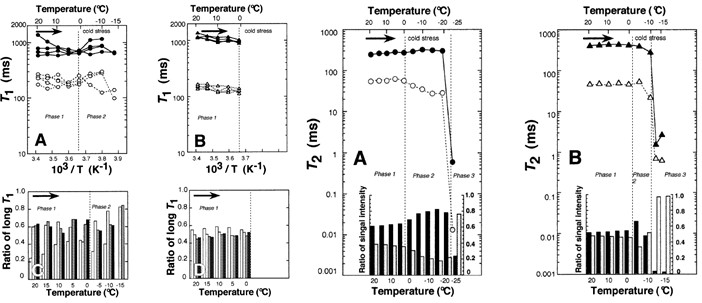Tiempo de relajación T1/T2 de RMN de campo bajo y técnicas de imagen en plantas tolerantes al frío
Low temperature will affect the normal physiological function of cells, and even cause the rupture and death of cells, affect the growth and development of plants or lead to plant death. These are closely related to the water status of plants. Why do many hardy plants survive normally at low temperatures for a long time? What is the state of the water inside them?
In temperate perennial herbaceous plants, overwintering capacity is mainly determined by the concentration of unstructured carbohydrates in the roots rather than the top. En cambio, heat stress is also a major factor limiting pasture growth in summer.
There are two kinds of water in plants: free water and bound water. The so-called “bound water”, based on its chemical composition and is not much different from free water. Except that free water’s molecules are arranged in a relatively messy order and can flow around, whereas the bound water molecules are arranged very neatly around the plant tissue and are closely “bound” to the plant tissue.
Bound water has very different properties from free water. Por ejemplo, free water starts to freeze at 0℃, but bound water freezes at a much lower temperature than normal water. During the cold winter, only free water is reduced in the plant, but the amount of bound water remains the same, so the proportion of bound water is increased. Since the bound water freezes at temperatures much lower than 0℃, hardy plants can, of course, stand out against the frost in the depths of winter.
Low-field NMR can nondestructively measure the state change of water. T1 and T2 relaxation time reflect the movement of water molecules and are used as indicators of water dynamics in biological tissues. Because the fluidity and properties of cell-associated water are closely related to cell conditions, MRI represents a physiological map of tissue and can be used to study the hydrodynamics of cell metabolism.
Conclusión:
(1) The Arrhenius diagram of T1 relaxation time and T2 relaxation time showed that water state reflected the cold and heat tolerance of leaves and roots
(2) The water content and water limitation of roots and leaves were correlated with T1 /T2 relaxation time.
(3) By measuring the T2 relaxation time, the leaves and roots of ryegrass had the ability of supercooling at -20 to -25℃ and -10℃ respectively.
(4) The lower fluidity of water in leaves may play an important role in response to temperature stress.
(5) MRI can reflect the freezing of different tissues.
Referencia: Cold- or Heat-Tolerance of Leaves and Roots in Perennial Ryegrass Determined by 1H-NMR
 mohoso
mohoso

